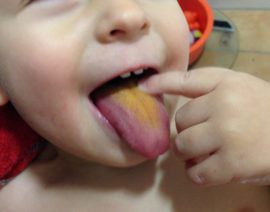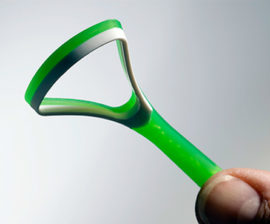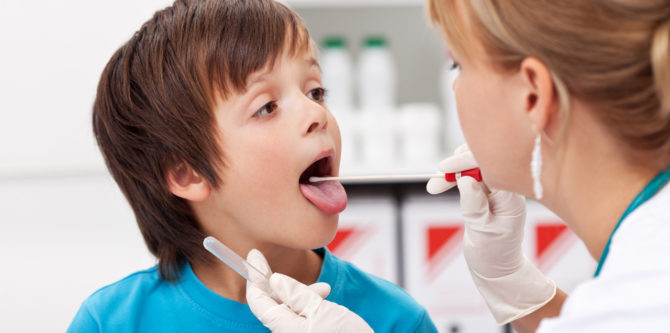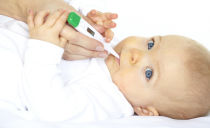Yellow plaque on the tongue in children and infants: causes and treatment
The relief, color and coloring of the tongue change throughout a person’s life. In children the norm is a pale pink tongue without a thick layer of plaque. Dense yellow, orange and brown deposits can indicate both insufficient oral hygiene and the development of internal or local diseases. Therefore, it is necessary to find out why a yellow coating appeared in the child’s language, together with the doctor.
Content
Why does a plaque appear in a child’s tongue
Plaque consists of particles of food, saliva, dead cells of the mucous membranes of the oral cavity, white blood cells, bacteria and their metabolic products. It accumulates in the language of every healthy adult and child and does not indicate a disease if it has a whitish hue and covers the taste organ with a thin layer: the relief of the tongue should be visible through the film.
In the photo you can see the state of the child’s tongue in the norm and with a pathological formation of white plaque:
Yellow plaque can occur in the child’s language for several reasons:
- Most often, the formation of white-yellow plaque is provoked by poor hygiene. To accustom the baby to hygiene procedures should be right after the eruption of the first teeth. Bacteria develop especially intensively at night, when the activity of the salivary glands decreases, so evening brushing your teeth and tongue with a toothbrush and paste should be an integral part of preparing for sleep.
- The manifestation of yellowness on the mucous membranes of the oral cavity may be a consequence of the use of certain products. In this case, pigmentation appears immediately after eating, is easily removed with a brush and does not occur again. Products that color the tongue in yellow: fruits and vegetables (carrots, apricots, persimmons, pumpkin, pineapple, orange), sweets and drinks with artificial food colors, some varieties of tea and coffee, seasonings (curry, saffron).
The yellow color of the tongue may be associated with the use of certain medications: cardiac glycosides, Enterofuril, Furazolidone, Akrikhina.
With pathological changes in the child’s body, not only the color of the plaque, but also its consistency can change: deposits become thick, problematically removed from the surface of the tongue. Such symptoms are almost always accompanied by a sharp bad breath. If these signs are found, you must immediately show the child to the doctor, as they can indicate:
- the development of infectious ailments;
- poisoning;
- dehydration;
- jaundice
- dental diseases;
- stomatitis;
- overeating;
- kidney disease;
- somatic and autoimmune pathologies.
Why does an orange plaque appear on the tongue
 Plaque on the tongue can be not only yellow or yellowish, but also orange, as in the photo. The orange color of the tongue in children and adults indicates that the contents of the stomach enter the oral cavity. This phenomenon is typical for exacerbation of gastritis with high acidity, pathologies of the esophagus, reflux disease, the initial stage of peptic ulcer.
Plaque on the tongue can be not only yellow or yellowish, but also orange, as in the photo. The orange color of the tongue in children and adults indicates that the contents of the stomach enter the oral cavity. This phenomenon is typical for exacerbation of gastritis with high acidity, pathologies of the esophagus, reflux disease, the initial stage of peptic ulcer.
In addition to the specific orange color of the tongue, a child may have a strange aftertaste in his mouth, periodic heartburn, belching. With such symptoms, it is necessary to treat not external manifestations, but the underlying disease.
Yellowish tongue coating in infants
In infants, a white or yellowish coating on the tongue often appears during the hot season. If it is not accompanied by other symptoms, then the baby is normal.
According to children's doctor Komarovsky, when white-yellowish deposits appear in the baby’s tongue, it is necessary to increase the amount of fluid consumed by him and protect him from overheating. But if the plaque acquires a brighter color, becomes more abundant and denser, it is necessary to consult a doctor. The cause of this phenomenon can be gastrointestinal diseases, malfunctions of the gallbladder, intoxication of the body due to an infectious disease or frequent constipation.
If a yellow or white coating appears in the tongue of an infant or child older than 1 year old, but still breastfeeding, the cause of the disorder must be sought in the gastric or intestinal imbalance. If there is constipation, heartburn, vomiting, you should analyze and adjust the menu of a nursing mother. If a yellow coating appears in the language of a child older than 2 years, does not disappear for more than two days and is not associated with ignoring the rules of hygiene, it is necessary to show the baby to the doctor.
Diagnosis and treatment of plaque in the language
To prescribe an effective treatment, the doctor must establish the cause of the appearance of yellow plaque in the child’s tongue. First, a full examination of the baby is carried out: the doctor examines the oral cavity and the surface of the tongue, conducts a physical examination of all organs and systems (tapping the chest, palpation). To clarify the diagnosis, one or more laboratory and instrumental studies are prescribed:
- General and biochemical analysis of blood and urine.
- Ultrasound of the abdominal cavity.
- Back sowing from the nasopharynx.
- FEGDS.
- Coprogram.
Based on the diagnostic results, a treatment regimen is determined aimed at eliminating the underlying disease that provoked the onset of plaque. Local treatment consists in intensive oral hygiene and nutritional correction. According to the famous pediatrician Komarovsky, professional toothbrushing in most cases is not required, rather thorough regular brushing of teeth and tongue at home.
If a plaque was formed due to improper nutrition, it is necessary to adjust the baby's diet:
- Products containing preservatives, colorants, flavor enhancers, thickeners should be completely excluded from the menu.
- It is necessary to reduce the amount of fat consumed by the child and prevent overeating.
- It is necessary to enrich the children's diet with cereals, dairy products, fresh fruits and vegetables.
- It is important to monitor the condition of the intestines of the child, to prevent constipation.
- If the baby is breastfeeding, it is required to control the mother’s diet.
Preventive actions
 To prevent the appearance of plaque in the child’s tongue, parents should include in their diet products that ensure the normal functioning of the gastrointestinal tract. It is necessary to ensure that the child regularly and thoroughly carries out hygiene procedures for caring for the oral cavity. Children under three years of age are brushed by adults; the procedure is performed 2 times a day. A child older than 3 years old and brushing his own teeth, you need to accustom to the fact that:
To prevent the appearance of plaque in the child’s tongue, parents should include in their diet products that ensure the normal functioning of the gastrointestinal tract. It is necessary to ensure that the child regularly and thoroughly carries out hygiene procedures for caring for the oral cavity. Children under three years of age are brushed by adults; the procedure is performed 2 times a day. A child older than 3 years old and brushing his own teeth, you need to accustom to the fact that:
- during brushing, it is necessary to remove plaque from the tongue, using a toothbrush or a special scraper, as in the photo;
- after each meal, rinse your mouth with a pharmacy antiseptic or clean boiled water.
To avoid the appearance of yellow plaque on the tongue of the baby during breastfeeding, the mother should follow her own menu. For newborns transferred to artificial feeding, you need to choose the right mixture that will ensure the proper functioning of the digestive tract. Dr. Komarovsky states that if the mixture is selected correctly, the baby should not have constipation.
In order to avoid infection of the mucous membranes of the oral cavity, it is necessary to carefully treat dishes, nipples and toys of the baby.







